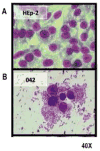Enteroaggregative coli: A Pathogen Bridging the North and South
- PMID: 24892007
- PMCID: PMC4039296
- DOI: 10.1007/s40475-014-0018-7
Enteroaggregative coli: A Pathogen Bridging the North and South
Abstract
Enteroaggregative Escherichia coli (EAEC) is a heterogeneous emerging enteric pathogen. Identified during the 1980's when EAEC strains where isolated from cases of acute and persistent diarrhea among infants from developing countries and of traveler's diarrhea. Subsequently, EAEC strains were linked with foodborne outbreaks and diarrhea illness in adults and children from industrialized countries, HIV-infected subjects and stunting of malnourished poor children. Nowadays, EAEC is increasingly recognized as a major cause of acute diarrhea in children recurring hospitalization and of traveler's diarrhea worldwide. EAEC strains defining phenotype is the aggregative adherence (AA) pattern on epithelial cells. AggR a transcriptional regulator of several EAEC virulence genes has been a key factor in both understanding EAEC pathogenesis and defining typical EAEC (tEAEC) strains. EAEC virulence genes distribution among these strains is highly variable. Present challenges are the identification of key virulence genes and how they coordinately function in the setting of enteric disease.
Keywords: Escherichia coli; GI infection; aggregative adherence (AA); enteroaggregative Escherichia coli (EAEC); epidemiology; identification; pathogen; tropical medicine.
Conflict of interest statement
Teresa Estrada-Garcia, Iza Perez-Martinez, Rodolfo Bernal-Reynaga, and Mussaret B. Zaidi declare that they have no conflict of interest.
Figures


References
Grants and funding
LinkOut - more resources
Full Text Sources
Other Literature Sources
